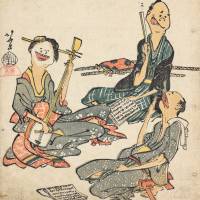An eel slithers up to cups of sake placed at a river's edge, while a goldfish atop a rock bravely swings a makeshift sword, protecting his cowering charge. Utagawa Kuniyoshi (1798-1861) caricatures multiple mythical and everyday scenes in his series The "Myriad Goldfish." This particular print illustrates an enactment of the slaying of Yamata no Orochi, a fearsome multi-headed serpent by the Shinto storm god, Susanoo, as described in the ancient Japanese text, the "Kojiki" (712).
Giga, a genre of farcical pictures of comical intent, has its origin in the Heian Period (794-1185) National Treasure "Scrolls of Frolicking Animals and Humans," attributed to Kakuyu (1053-1140), also known as Toba Sojo (Bishop of Toba). "Caricatures of the Edo Period" at the Osaka City Museum of Fine Arts, however, has a narrower historical focus on the simply painted humorous pictures and illustrations, designated as toba-e, that became popular in Osaka (formerly Naniwa) in the 18th century.
The earliest paintings of the kind were on fans and wrapping cloths (fukusa), then, attesting to their popularity, in illustrated books. Osaka's toba-e influence flowed into the flowering of Edo Period (1603-1868) ukiyo-e print culture, and beyond, while latter day caricaturists paid tribute to their artistic predecessors.
The extremely popular works of the elusive Edo Period artist Nichosai, thought to have been an Osaka sake brewer and antiques dealer, are the exhibition's starting point. Nichosai created comically contrastive imagery by playing on commonly known narratives, including hell scenes in which fishmongers were skewered and grilled like their produce, and kabuki actors were cooked in pots with daikon radishes.
Katsushika Hokusai (1760-1849) paid tribute to his sources in "Collection of Toba-style Paintings." His "Bell Ringer" clearly showed the influence of the "Toba-style Comic Sketchbook," which had been published in Osaka roughly 90 years earlier. In addition to anthropomorphized goldfish, Kuniyoshi, called the "great master of caricature," also depicted a form of pseudo-graffiti in "Actor Caricatures Scribbled on Dirt Walls," using a pictorial and conceptual repertoire similar to that established by Nichosai.
Caricaturing meisho-e, the pictorial genre of illustrating famous places, became popular in ukiyo-e at the end of the Edo Period, with Tokyo, Kyoto and Osaka as backdrops to somewhat slapstick scenes: a man tricked by foxes at Oji (Tokyo), a woman jumping off the famous viewing platform at Kiyomizu Temple (Kyoto), and people tumbling around on the drum bridge of Sumiyoshi Shrine (Osaka). These themes, such as the woman jumping, Mary Poppins-like with a parasol, off the viewing platform find earlier visual representation in toba-e from Osaka.
The eccentric painter and printmaker Kawanabe Kyosai (1831-1889) is the last in the artistic lineage addressed at the exhibition. Beginning painting at age 7 under the tutelage of Kuniyoshi, Kyosai's "Racoon Dogs at Play" indicates an alignment with the pictorial taste of his teacher. His "Attack of the Octopus" references toba-e, and other works borrow from the "Hokusai Manga." Kyosai's anthropomorphized frogs and depictions of the legendary "fart battle" attributed to the Bishop of Toba, pay homage to the origins of Japanese caricature.
Sometimes vulgar or ridiculous, and occasionally cliched, toba-e offer a panorama of what has been historically considered amusing.
"Caricatures of the Edo Period: From Toba-Style Paintings to Hokusai, Kuniyoshi and Kyosai" at the Osaka City Museum of Fine Arts runs until June 10; ¥1,400. For more information, visit www.osaka-art-museum.jp.

















With your current subscription plan you can comment on stories. However, before writing your first comment, please create a display name in the Profile section of your subscriber account page.